Index to Trees & Shrubs in the Order Myrtales
Family: Combretaceae (Bushwillow Family)
532. Combretum apiculatum apiculatum Red Bushwillow https://africawild-forum.com/viewtopic. ... 72#p506072
539. Combretum imberbe Leadwood, Leadwood Bushwillow https://africawild-forum.com/viewtopic. ... 41#p171441
545. Combretum microphyllum Flame Creeper https://africawild-forum.com/viewtopic. ... 41#p171442
546. Combretum zeyheri Large-fruited Bushwillow https://africawild-forum.com/viewtopic. ... 67#p506067
550. Terminalia prunioides Purplepod Clusterleaf, Lowveld Cluster-leaf https://africawild-forum.com/viewtopic. ... 41#p180041
551. Terminalia sericea Silver Cluster-leaf, Silver Terminalia https://africawild-forum.com/viewtopic. ... 45#p171445
Family: Myrtaceae (Myrtle and Eucalyptus Family)
X812. Corymbia ficifolia Red-Flowering Gum https://africawild-forum.com/viewtopic. ... 48#p171448
555. Syzygium cordatum Waterberry, Umdoni https://africawild-forum.com/viewtopic. ... 90#p285390
557. Syzygium guineense Woodland Waterberry, Waterpear https://africawild-forum.com/viewtopic. ... 49#p171449
Africa Wild Tree & Shrub Book - Order Myrtales
Moderator: Klipspringer
Re: Africa Wild Tree & Shrub Book - Order Myrtales
539. Leadwood, Leadwood Bushwillow Combretum imberbe (Hardekool)
Order: Myrtales. Family: Combretaceae


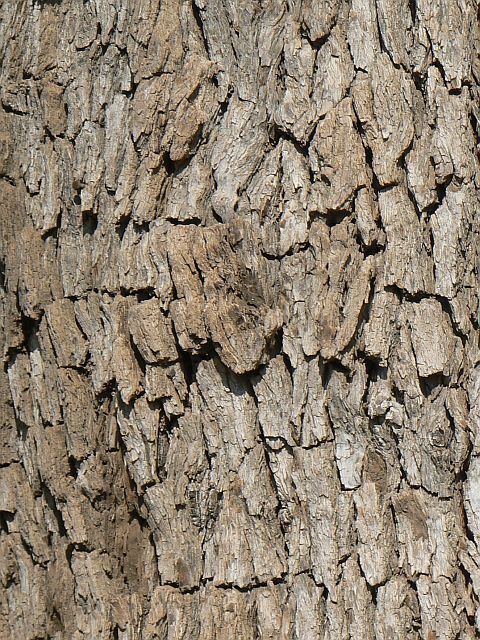
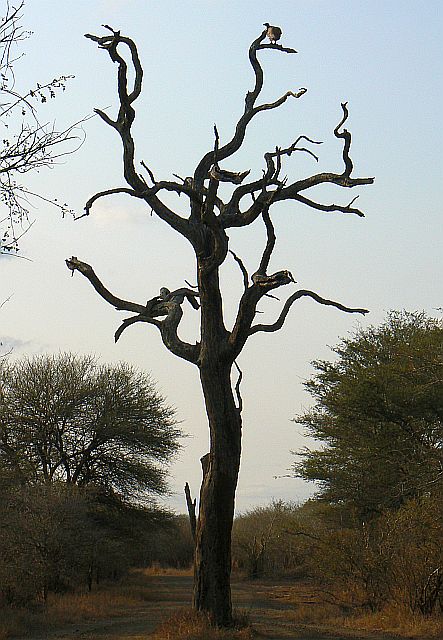
Dead Leadwood on the S130, Kruger National Park
Description
A medium to large, semi-deciduous tree, which grows up to 20 m in height. The leadwood is the tallest of all the South African combretums. It has a spreading canopy and is extremely slow growing. The snakeskin-like bark is one of the main features that make identification easier throughout the season. Bark pale to dark grey, deeply fissured lengthwise with irregular horizontal cracks; young stems with spine-like opposite branchlets. Dead branches and shoots often remain on a matured tree. The colour of the trunk is pale grey to white. The leathery leaves are arranged opposite each other. Leaves elliptic to obovate, often on short, spine-like lateral shoots, grey-green above, hairless, but covered in whitish scales beneath. The flowers are yellowish cream-coloured and have a sweet fragrance. They are produced from November to March. Combretum imberbe produces 4-winged fruit, usually less than 1.5 cm, yellowish green, fruits turn pale red when mature from February to June.
Distribution
From Tanzania to Angola, Botswana, Namibia, and Limpopo and Mpumalanga, South Africa. It is widespread in Lowveld areas and grows along streams and rivers. It is also found in Mpumalanga, Limpopo, North-West Province, Mozambique, and into tropical Africa.
Habitat
Found in all the bushveld regions and in mixed forest and along dry watercourses.
Links: Wild About Trees; Braam Van Wyk, Piet Van Wyk: Field Guide to Trees of Southern Africa; Ernst Schmidt, Mervyn Lotter, Warren McCleland: Trees and Shrubs of Mpumalanga and Kruger National Park
Order: Myrtales. Family: Combretaceae




Dead Leadwood on the S130, Kruger National Park
Description
A medium to large, semi-deciduous tree, which grows up to 20 m in height. The leadwood is the tallest of all the South African combretums. It has a spreading canopy and is extremely slow growing. The snakeskin-like bark is one of the main features that make identification easier throughout the season. Bark pale to dark grey, deeply fissured lengthwise with irregular horizontal cracks; young stems with spine-like opposite branchlets. Dead branches and shoots often remain on a matured tree. The colour of the trunk is pale grey to white. The leathery leaves are arranged opposite each other. Leaves elliptic to obovate, often on short, spine-like lateral shoots, grey-green above, hairless, but covered in whitish scales beneath. The flowers are yellowish cream-coloured and have a sweet fragrance. They are produced from November to March. Combretum imberbe produces 4-winged fruit, usually less than 1.5 cm, yellowish green, fruits turn pale red when mature from February to June.
Distribution
From Tanzania to Angola, Botswana, Namibia, and Limpopo and Mpumalanga, South Africa. It is widespread in Lowveld areas and grows along streams and rivers. It is also found in Mpumalanga, Limpopo, North-West Province, Mozambique, and into tropical Africa.
Habitat
Found in all the bushveld regions and in mixed forest and along dry watercourses.
Links: Wild About Trees; Braam Van Wyk, Piet Van Wyk: Field Guide to Trees of Southern Africa; Ernst Schmidt, Mervyn Lotter, Warren McCleland: Trees and Shrubs of Mpumalanga and Kruger National Park
Re: Africa Wild Tree & Shrub Book - Order Myrtales
545. Flame Creeper, Flame Climbing Bushwillow Combretum microphyllum
Order: Myrtales. Family: Combretaceae
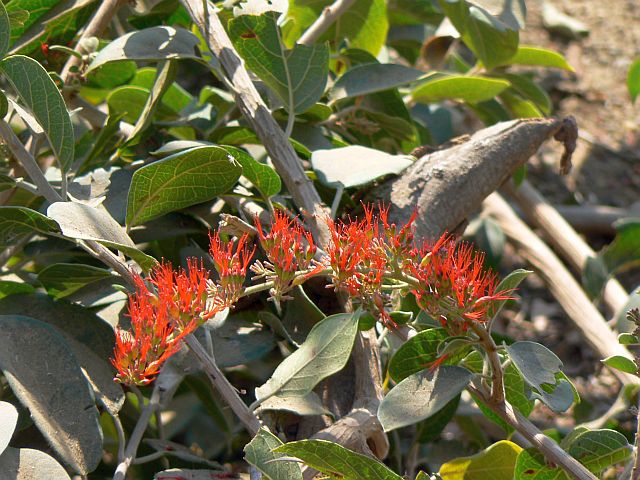

Kruger National Park, Crook's Corner
Description
A robust, deciduous climber, sometimes a scrambling shrub or small tree. Masses of small flowers with bright red petals and long stamens form massed sprays which festoon the branches for about three weeks in spring (August to November) before the new leaves appear. The oval leaves are 13-60 mm long and 13-50 mm wide. Leaf base rounded. Stalk glandes on the leaves. Sometimes short recurved spines. The fruit is 4-winged, green tinged with red or pink when young, drying to pale yellowish brown (September to January).
Distribution
Widespread throughout southern Africa, mainly found in the northeastern parts of South Africa (Lowveld, KwaZulu-Natal) and also found in Swaziland, Zimbabwe, Mozambique, Malawi and Tanzania.
Habitat
It is found in bushveld and woodland areas, often along rivers.
Links: Val Thomas, Rina Grant: Sappi Tree Spotting: Kwazulu-Natal and Eastern Cape
Order: Myrtales. Family: Combretaceae


Kruger National Park, Crook's Corner
Description
A robust, deciduous climber, sometimes a scrambling shrub or small tree. Masses of small flowers with bright red petals and long stamens form massed sprays which festoon the branches for about three weeks in spring (August to November) before the new leaves appear. The oval leaves are 13-60 mm long and 13-50 mm wide. Leaf base rounded. Stalk glandes on the leaves. Sometimes short recurved spines. The fruit is 4-winged, green tinged with red or pink when young, drying to pale yellowish brown (September to January).
Distribution
Widespread throughout southern Africa, mainly found in the northeastern parts of South Africa (Lowveld, KwaZulu-Natal) and also found in Swaziland, Zimbabwe, Mozambique, Malawi and Tanzania.
Habitat
It is found in bushveld and woodland areas, often along rivers.
Links: Val Thomas, Rina Grant: Sappi Tree Spotting: Kwazulu-Natal and Eastern Cape
Re: Africa Wild Tree & Shrub Book - Order Myrtales
551. Silver Cluster-leaf, Silver Terminalia Terminalia sericea (Vaalboom)
Order: Myrtales. Family: Combretaceae
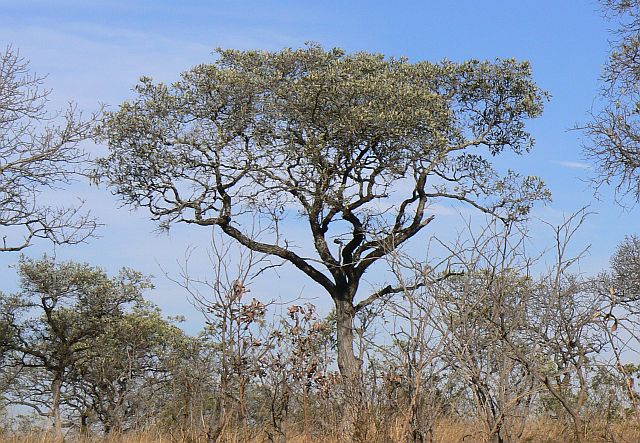
Kruger National Park
Description
Terminalia sericea is a silvery-blue, upright, single-trunked tree. It is a medium to large tree, the height being 6-20 m, with moderate density. It has reddish-brown branches. The branches leave the trunk at different levels to form distinct, horizontal layers.
The rough, dark bark is deeply fissured lengthwise.
The leaves are crowded at the ends of branches, narrowly obovate-elliptic with smooth margins, blue-green above, paler below, densely covered in silvery hairs, giving the tree a characteristic silver shine.
It flowers mostly in September–January. The flowers are in axillary spikes and are pale yellow to creamy white. The fruit is an oval nut surrounded by a flat wing.
Two-winged pods are produced in bunches at the ends of the branches. Pods ripen during March and April, and change from light red to light brown in colour. (January to June: 60 x 15 mm) They remain on the tree almost until the following flowering season. The fruits are often parasitized and form deformed masses of thin round galls.
Distribution
It occurs from Tanzania and the DRC southwards to Angola and Namibia, Zimbabwe, Botswana and South Africa.
Habitat
Terminalia sericea occurs in a variety of types of open woodlands. It prefers deep, well-drained, sandy soils. It may grow as a dominant or co-dominant species in mixed deciduous forests such as Brachystegia, mopane, Combretum or Acacia forest. It is very common in the higher rainfall areas.
Links: PlantZAfrica; Ernst Schmidt, Mervyn Lotter, Warren McCleland: Trees and Shrubs of Mpumalanga and Kruger National Park
Order: Myrtales. Family: Combretaceae

Kruger National Park
Description
Terminalia sericea is a silvery-blue, upright, single-trunked tree. It is a medium to large tree, the height being 6-20 m, with moderate density. It has reddish-brown branches. The branches leave the trunk at different levels to form distinct, horizontal layers.
The rough, dark bark is deeply fissured lengthwise.
The leaves are crowded at the ends of branches, narrowly obovate-elliptic with smooth margins, blue-green above, paler below, densely covered in silvery hairs, giving the tree a characteristic silver shine.
It flowers mostly in September–January. The flowers are in axillary spikes and are pale yellow to creamy white. The fruit is an oval nut surrounded by a flat wing.
Two-winged pods are produced in bunches at the ends of the branches. Pods ripen during March and April, and change from light red to light brown in colour. (January to June: 60 x 15 mm) They remain on the tree almost until the following flowering season. The fruits are often parasitized and form deformed masses of thin round galls.
Distribution
It occurs from Tanzania and the DRC southwards to Angola and Namibia, Zimbabwe, Botswana and South Africa.
Habitat
Terminalia sericea occurs in a variety of types of open woodlands. It prefers deep, well-drained, sandy soils. It may grow as a dominant or co-dominant species in mixed deciduous forests such as Brachystegia, mopane, Combretum or Acacia forest. It is very common in the higher rainfall areas.
Links: PlantZAfrica; Ernst Schmidt, Mervyn Lotter, Warren McCleland: Trees and Shrubs of Mpumalanga and Kruger National Park
Re: Africa Wild Tree & Shrub Book - Order Myrtales
X812. Red-Flowering Gum Corymbia ficifolia, previously known as Eucalyptus ficifolia (Rooiblombloekom)
Order: Myrtales. Family: Myrtaceae
 © Lisbeth
© Lisbeth
On the R62 close to Joubertina, Eastern Cape
 © Lisbeth
© Lisbeth
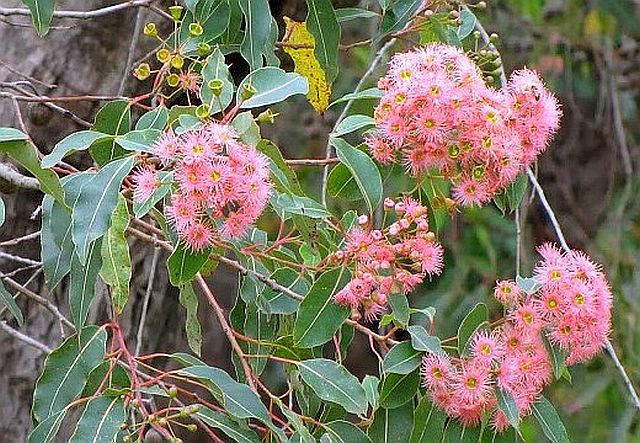 © Lisbeth
© Lisbeth
KwaZulu-Natal, South Coast
Description
Tree, usually small and straggly, to 10 m tall. Forming a lignotuber. Bark rough to the small branches, fibrous, rarely tessellated, brown to grey-brown. Branchlets lacking oil glands in the pith.
Adult leaves alternate, petioles 0.8–2 cm long; blade ovate to broadly lanceolate, 7–13 cm long, 2.5–5 cm wide, flat to slightly undulate, dull to slightly glossy, discolorous, darker green above, paler below, base tapering to the petiole, occasionally rounded, margin entire, apex acute, side-veins penniveined, reticulation very dense, intramarginal vein present but very close to the leaf margin (almost confluent), oil glands obscure or absent, island.
Like many other species in the Myrtaceae family, the flowers are made up of stamens with no petals. Inflorescences terminal, peduncles 1.5–3.2 cm long; buds 7 per umbel, pedicels 1.3–2.7 cm long. Mature buds obovoid to pyriform, 1.2–1.8 cm long, 0.6–0.8 cm wide, surface smooth (not scurfy), scar absent, operculum rounded to flattened, stamens inflexed, anthers oblong, versatile, dorsifixed, dehiscing by longitudinal slits, style long and straight, stigma papillate (mop-like), locules commonly 3 (rarely 4), ovules not in regular rows. Flowers bright red to pink to orange.
Fruit pedicellate (pedicels 1.5–2.7) cm long, urceolate (rarely truncate-ovoid to truncate-globose), 2–4.2 cm long, 1.8–3 cm wide, disc vertically descending, valves 3 (rarely 4), deeply enclosed.
Seed dark brown to black, ellipsoidal with terminal wing, often extending narrowly along margins also, 12–18 mm long (including wing).
Distribution
Alien species . Native to Western Australia. Naturalized in South Africa, mainly found in eastern Mpumalanga, KwaZulu-Natal and the Eastern and Western Cape.
. Native to Western Australia. Naturalized in South Africa, mainly found in eastern Mpumalanga, KwaZulu-Natal and the Eastern and Western Cape.
Habitat
It occurs in sandy or rocky soils.
Links: Bill Sheat, Gerald Schofield: Complete Gardening in Southern Africa
Order: Myrtales. Family: Myrtaceae
 © Lisbeth
© LisbethOn the R62 close to Joubertina, Eastern Cape
 © Lisbeth
© Lisbeth © Lisbeth
© LisbethKwaZulu-Natal, South Coast
Description
Tree, usually small and straggly, to 10 m tall. Forming a lignotuber. Bark rough to the small branches, fibrous, rarely tessellated, brown to grey-brown. Branchlets lacking oil glands in the pith.
Adult leaves alternate, petioles 0.8–2 cm long; blade ovate to broadly lanceolate, 7–13 cm long, 2.5–5 cm wide, flat to slightly undulate, dull to slightly glossy, discolorous, darker green above, paler below, base tapering to the petiole, occasionally rounded, margin entire, apex acute, side-veins penniveined, reticulation very dense, intramarginal vein present but very close to the leaf margin (almost confluent), oil glands obscure or absent, island.
Like many other species in the Myrtaceae family, the flowers are made up of stamens with no petals. Inflorescences terminal, peduncles 1.5–3.2 cm long; buds 7 per umbel, pedicels 1.3–2.7 cm long. Mature buds obovoid to pyriform, 1.2–1.8 cm long, 0.6–0.8 cm wide, surface smooth (not scurfy), scar absent, operculum rounded to flattened, stamens inflexed, anthers oblong, versatile, dorsifixed, dehiscing by longitudinal slits, style long and straight, stigma papillate (mop-like), locules commonly 3 (rarely 4), ovules not in regular rows. Flowers bright red to pink to orange.
Fruit pedicellate (pedicels 1.5–2.7) cm long, urceolate (rarely truncate-ovoid to truncate-globose), 2–4.2 cm long, 1.8–3 cm wide, disc vertically descending, valves 3 (rarely 4), deeply enclosed.
Seed dark brown to black, ellipsoidal with terminal wing, often extending narrowly along margins also, 12–18 mm long (including wing).
Distribution
Alien species
Habitat
It occurs in sandy or rocky soils.
Links: Bill Sheat, Gerald Schofield: Complete Gardening in Southern Africa
Re: Africa Wild Tree & Shrub Book - Order Myrtales
557. Woodland Waterberry, Waterpear Syzygium guineense (Waterpeer)
Order: Myrtales. Family: Myrtaceae
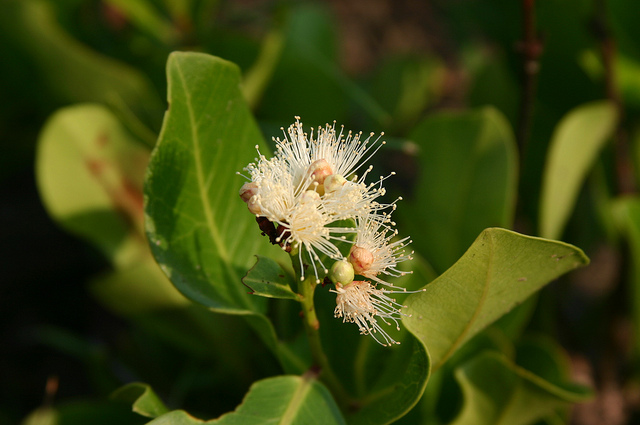 © Moggiedog
© Moggiedog
Zimbabwe
Description
A medium-sized or tall evergreen tree, 15-30 m high. The bark varies in subspecies and is greyish-white or silver mottled and smooth in young trees, turning rough, flaky, creamy, light grey, dark brown or black in older trees. Bark scales in rectangular flakes and produces red, watery sap if cut; slash is fibrous, even pale brown to dark red-brown. Branchlets sometimes drooping. Crown rounded and heavy; stems thick and angular.
Leaves narrow at both ends, length 5-17.5 cm, width 1.3-7.5 cm; simple, opposite, elliptic, lanceolate or ovate-elliptic; with margins that are untoothed and sometimes slightly wavy and rolled inward; apex obtuse to acuminate and rounded, occasionally notched; base cuneate; stalk short and grooved; midrib sunken on top, raised below, with many fine, lateral veins; glabrous, grey-green, tough, shiny; fragrant when crushed.
Flowers (filaments) 1.5 cm in diameter, sessile or subsessile, fragrant, creamy white; borne in terminal panicles forming heads up to 10 x 10 cm, or with 4-8 widely spaced flowers in branched heads up to 3 cm in diameter; calyx persistent with 4 petals; stamens numerous, about 6 mm long. Petals fall early but the white stamens are showy, making a conspicuous short brush or puff contrasting with the red or pink calyx tips.
Fruits ovoid or ellipsoid drupes, 1.2-3.5 cm x 1 x 2.5 cm, 2-3 celled, in bunches of 20 to 30, whitish-green when immature, turning to shiny purplish-black and juicy after ripening; 1-seeded. Seeds are 1.3-1.4 cm in diameter, yellowish to brownish and rounded.
Distribution
Widespread from northern KwaZulu-Natal through Swaziland, Mpumalanga, Limpopo to Mozambique, Zimbabwe, northern Botswana and northern Namibia towards central Africa.
Habitat
It usually occurs in lowland forests, in areas close to swamps and sometimes along river banks, usually in moist conditions and sometimes even in water.
Links: Ernst Schmidt, Mervyn Lotter, Warren McCleland: Trees and Shrubs of Mpumalanga and Kruger National Park; Braam Van Wyk, Piet Van Wyk: Field Guide to Trees of Southern Africa
Order: Myrtales. Family: Myrtaceae
 © Moggiedog
© MoggiedogZimbabwe
Description
A medium-sized or tall evergreen tree, 15-30 m high. The bark varies in subspecies and is greyish-white or silver mottled and smooth in young trees, turning rough, flaky, creamy, light grey, dark brown or black in older trees. Bark scales in rectangular flakes and produces red, watery sap if cut; slash is fibrous, even pale brown to dark red-brown. Branchlets sometimes drooping. Crown rounded and heavy; stems thick and angular.
Leaves narrow at both ends, length 5-17.5 cm, width 1.3-7.5 cm; simple, opposite, elliptic, lanceolate or ovate-elliptic; with margins that are untoothed and sometimes slightly wavy and rolled inward; apex obtuse to acuminate and rounded, occasionally notched; base cuneate; stalk short and grooved; midrib sunken on top, raised below, with many fine, lateral veins; glabrous, grey-green, tough, shiny; fragrant when crushed.
Flowers (filaments) 1.5 cm in diameter, sessile or subsessile, fragrant, creamy white; borne in terminal panicles forming heads up to 10 x 10 cm, or with 4-8 widely spaced flowers in branched heads up to 3 cm in diameter; calyx persistent with 4 petals; stamens numerous, about 6 mm long. Petals fall early but the white stamens are showy, making a conspicuous short brush or puff contrasting with the red or pink calyx tips.
Fruits ovoid or ellipsoid drupes, 1.2-3.5 cm x 1 x 2.5 cm, 2-3 celled, in bunches of 20 to 30, whitish-green when immature, turning to shiny purplish-black and juicy after ripening; 1-seeded. Seeds are 1.3-1.4 cm in diameter, yellowish to brownish and rounded.
Distribution
Widespread from northern KwaZulu-Natal through Swaziland, Mpumalanga, Limpopo to Mozambique, Zimbabwe, northern Botswana and northern Namibia towards central Africa.
Habitat
It usually occurs in lowland forests, in areas close to swamps and sometimes along river banks, usually in moist conditions and sometimes even in water.
Links: Ernst Schmidt, Mervyn Lotter, Warren McCleland: Trees and Shrubs of Mpumalanga and Kruger National Park; Braam Van Wyk, Piet Van Wyk: Field Guide to Trees of Southern Africa
- nan
- Posts: 26481
- Joined: Thu May 31, 2012 9:41 pm
- Country: Switzerland
- Location: Central Europe
- Contact:
Re: Africa Wild Tree & Shrub Book - Order Myrtales
550. Purplepod Clusterleaf, Lowveld Cluster-leaf Terminalia prunioides (Bloedboom, Sterkbos)
Order: Myrtales. Family: Combretaceae
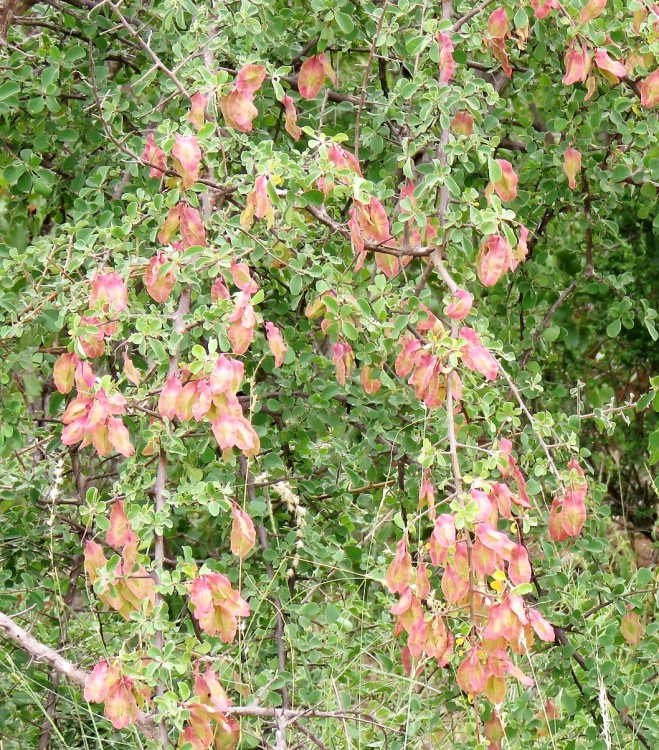 © Lisbeth
© Lisbeth
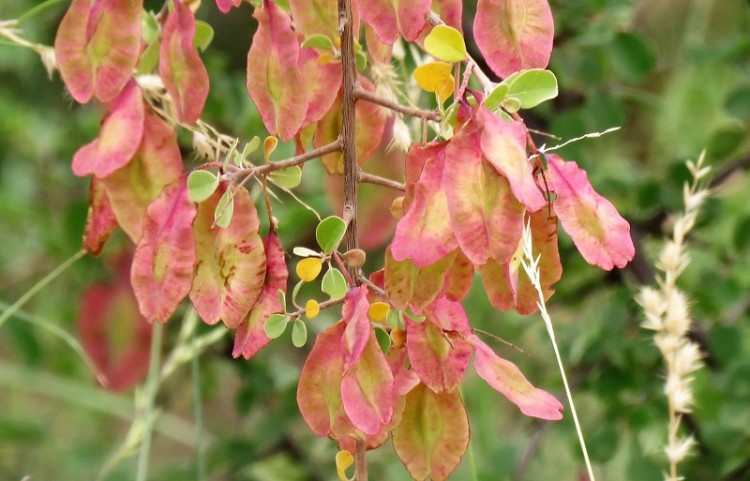 © Lisbeth
© Lisbeth
Kruger National Park

Kruger National Park, Timbavati picnic spot 13.3.2008
Description
Terminalia prunioides is a small, deciduous tree (min. 2.5) 4.6-15 m high with a girth of 1.5 m. It may be single or multistemmed, with bark that is light grey, ribbed longitudinally (sometimes deeply); bark on the twigs strips off in small lengths. Long, smooth, arching wands of branches spread outwards and downwards. The short, rigid, usually purplish twigs grow sharply outwards and at right angles to the branches, with the leaves and flowers crowded at their tips. The silhouette of the tree is thus spiky. Spines are often present on the long branches.
Leaves clustered on spine-like lateral branchlets. Leaves are small, 1.3-7.5 cm long and up to 3 cm broad; oval or egg-shaped, commonly widest in the upper half and tapered to the base; dark green above and lighter below; pubescent when young, later glabrous; base cuneate or attenuate; margin entire; apex round, notched or pointed; petiole almost obscured by the decurrent leaf base. Leaves shed irregularly.
Flowers are starry, small, white or cream, without petals but with a puff of conspicuous yellow stamens; widely spaced in slender, axillary spikes 4-8 cm long, at the end of short branchlets. The smell is strong and unpleasant. Each inflorescence contains bisexual and male flowers, male flowers towards the apex, bisexual flowers towards the base.
Fruits are 3.5-6.5 cm long, 2-3 cm wide; oval or oblong, tips notched; seed in the thickened centre surrounded by a tough, flat wing, purple or deep red when mature; seeds 2.5 x 2 cm, 2-winged, light red to red-purple; endocarp hard and woody, 1-seeded.
Distribution
Native to Angola, Botswana, Djibouti, Eritrea, Ethiopia, Kenya, Lesotho, Mozambique, Namibia, South Africa (Limpopo, Mpumalanga), Swaziland, Tanzania, Zambia, Zimbabwe.
Habitat
In hot, low-altitude open woodland and rocky hillsides.
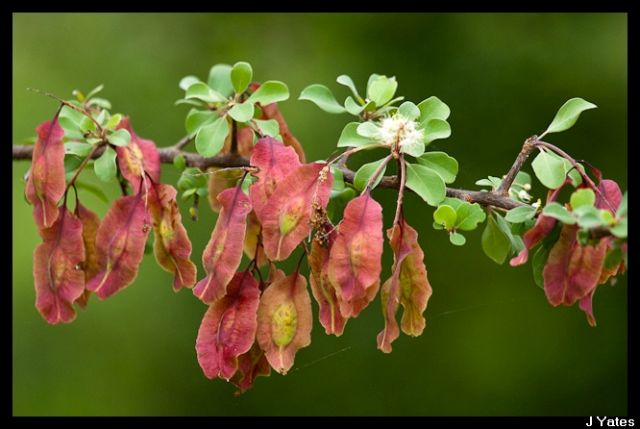 © Kesheshe
© Kesheshe
Kruger National Park
Links: Trees and Shrubs of Mpumalanga and Kruger National Park
Order: Myrtales. Family: Combretaceae
Kruger National Park

Kruger National Park, Timbavati picnic spot 13.3.2008
Description
Terminalia prunioides is a small, deciduous tree (min. 2.5) 4.6-15 m high with a girth of 1.5 m. It may be single or multistemmed, with bark that is light grey, ribbed longitudinally (sometimes deeply); bark on the twigs strips off in small lengths. Long, smooth, arching wands of branches spread outwards and downwards. The short, rigid, usually purplish twigs grow sharply outwards and at right angles to the branches, with the leaves and flowers crowded at their tips. The silhouette of the tree is thus spiky. Spines are often present on the long branches.
Leaves clustered on spine-like lateral branchlets. Leaves are small, 1.3-7.5 cm long and up to 3 cm broad; oval or egg-shaped, commonly widest in the upper half and tapered to the base; dark green above and lighter below; pubescent when young, later glabrous; base cuneate or attenuate; margin entire; apex round, notched or pointed; petiole almost obscured by the decurrent leaf base. Leaves shed irregularly.
Flowers are starry, small, white or cream, without petals but with a puff of conspicuous yellow stamens; widely spaced in slender, axillary spikes 4-8 cm long, at the end of short branchlets. The smell is strong and unpleasant. Each inflorescence contains bisexual and male flowers, male flowers towards the apex, bisexual flowers towards the base.
Fruits are 3.5-6.5 cm long, 2-3 cm wide; oval or oblong, tips notched; seed in the thickened centre surrounded by a tough, flat wing, purple or deep red when mature; seeds 2.5 x 2 cm, 2-winged, light red to red-purple; endocarp hard and woody, 1-seeded.
Distribution
Native to Angola, Botswana, Djibouti, Eritrea, Ethiopia, Kenya, Lesotho, Mozambique, Namibia, South Africa (Limpopo, Mpumalanga), Swaziland, Tanzania, Zambia, Zimbabwe.
Habitat
In hot, low-altitude open woodland and rocky hillsides.
 © Kesheshe
© KeshesheKruger National Park
Links: Trees and Shrubs of Mpumalanga and Kruger National Park
Kgalagadi lover… for ever
https://safrounet.piwigo.com/
https://safrounet.piwigo.com/
Re: Africa Wild Tree & Shrub Book - Order Myrtales
555. Waterberry, Umdoni Syzygium cordatum (Waterbessie)
Order: Myrtales. Family: Myrtaceae
 © Tina
© Tina
 © Tina
© Tina
Mtuzini, KwaZulu-Natal
Description
Syzygium cordatum is a medium-sized tree, 6-15 (max. 20) m in height; dwarf forms 30-45 cm high have been reported; young trunks banded and blotched in grey and white and are fairly smooth; in old trees the bark is dark brown, light grey or reddish, thick, rough, fissured and can be pulled off in thick, corklike, square pieces; young stems squarish with winged edges.
Leaves very many, near the ends of branches, thick, leathery, smooth, opposite, elliptic, oval or almost circular, up to 2.5-13 x 1.9-8 cm, bluish-green on top, paler green under, gland dots inconspicuous; apex bluntly pointed to rounded; base round and notched; margin entire and often wavy; petiole absent or extremely short; midrib lateral with conspicuous net veins; usually stalkless but may occasionally have short stalks, in which case they may be confused with those of S. guineense; new foliage is bright red.
Buds sturdy, in dense, branched terminal sprays, their round shiny pink tops appearing just above the smooth, green calyx. Open into creamy white to pinkish, sweetly scented flowers that yield excellent, abundant nectar; petals fall early, leaving the stamens forming an airy puff; stamens the most conspicuous feature, in dense heads, about 2-2.5 (max. 10) cm in diameter at the ends of branches; filaments 10-15 mm long.
Fruit an ovoid, fleshy berry, about 1.3-1.5 cm, slightly oblong, deep pink, purple or purple-black when mature, ellipsoid with a permanent calyx on top, 10-18 mm long; inside the fruit is a single, whitish seed.
Distribution
It occurs along streambanks from KwaZulu-Natal northwards to Mozambique. Provincial distribution in South Africa: Eastern Cape, KwaZulu-Natal, Limpopo, Mpumalanga.
Habitat
It grows in forest margins, in bush or open grassy and sometimes high country.
Links: Braam Van Wyk, Piet Van Wyk: Field Guide to Trees of Southern Africa; PlantZAfrica
Order: Myrtales. Family: Myrtaceae
 © Tina
© Tina © Tina
© TinaMtuzini, KwaZulu-Natal
Description
Syzygium cordatum is a medium-sized tree, 6-15 (max. 20) m in height; dwarf forms 30-45 cm high have been reported; young trunks banded and blotched in grey and white and are fairly smooth; in old trees the bark is dark brown, light grey or reddish, thick, rough, fissured and can be pulled off in thick, corklike, square pieces; young stems squarish with winged edges.
Leaves very many, near the ends of branches, thick, leathery, smooth, opposite, elliptic, oval or almost circular, up to 2.5-13 x 1.9-8 cm, bluish-green on top, paler green under, gland dots inconspicuous; apex bluntly pointed to rounded; base round and notched; margin entire and often wavy; petiole absent or extremely short; midrib lateral with conspicuous net veins; usually stalkless but may occasionally have short stalks, in which case they may be confused with those of S. guineense; new foliage is bright red.
Buds sturdy, in dense, branched terminal sprays, their round shiny pink tops appearing just above the smooth, green calyx. Open into creamy white to pinkish, sweetly scented flowers that yield excellent, abundant nectar; petals fall early, leaving the stamens forming an airy puff; stamens the most conspicuous feature, in dense heads, about 2-2.5 (max. 10) cm in diameter at the ends of branches; filaments 10-15 mm long.
Fruit an ovoid, fleshy berry, about 1.3-1.5 cm, slightly oblong, deep pink, purple or purple-black when mature, ellipsoid with a permanent calyx on top, 10-18 mm long; inside the fruit is a single, whitish seed.
Distribution
It occurs along streambanks from KwaZulu-Natal northwards to Mozambique. Provincial distribution in South Africa: Eastern Cape, KwaZulu-Natal, Limpopo, Mpumalanga.
Habitat
It grows in forest margins, in bush or open grassy and sometimes high country.
Links: Braam Van Wyk, Piet Van Wyk: Field Guide to Trees of Southern Africa; PlantZAfrica
-
Klipspringer
- Global Moderator
- Posts: 5858
- Joined: Sat Sep 14, 2013 12:34 pm
- Country: Germany
- Contact:
Re: Africa Wild Tree & Shrub Book - Order Myrtales
546. Large-fruited Bushwillow Combretum zeyheri (Raasblaar)
Order: Myrtales. Family: Combretaceae
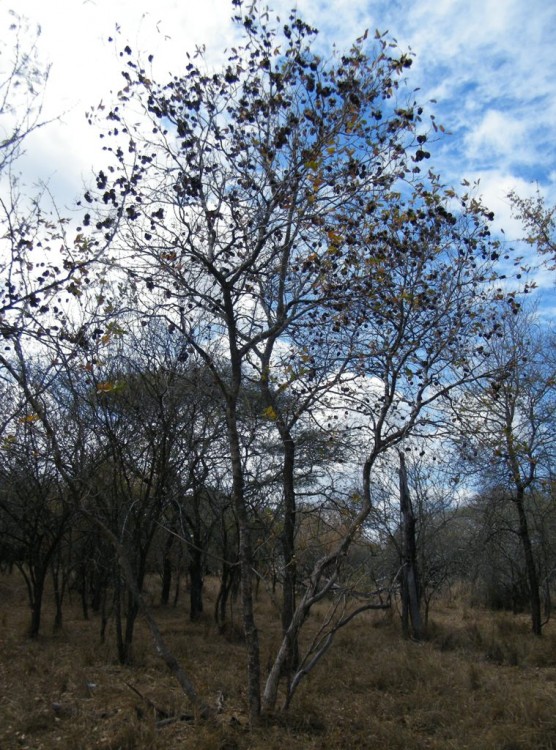 © Richprins
© Richprins
 © Richprins
© Richprins
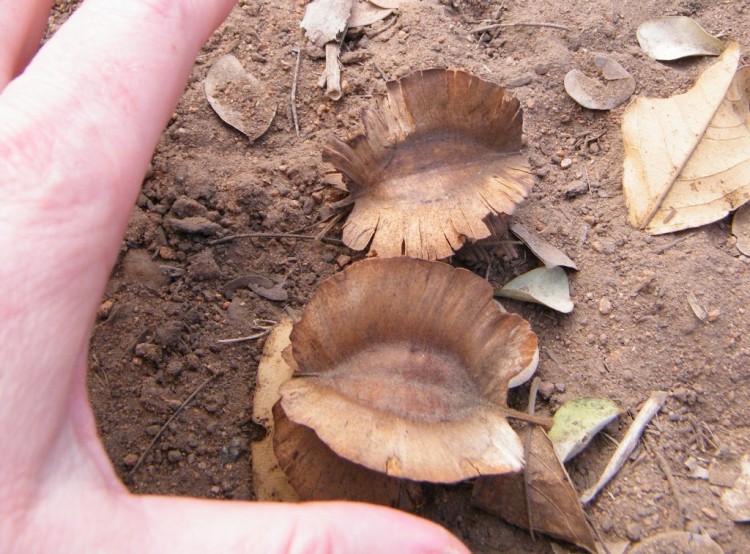 © Richprins
© Richprins
Marloth Park, Mpumalanga
Description
Combretum zeyheri is a deciduous or semi-deciduous tree of up to 10–15 m high, with a rounded crown, branched and often with twisted trunks.
Bark on younger stem is whitish and hairy; stems have prominently thickened nodes, smooth and flaking; small twigs are reddish and drooping.
Leaves clustered near the ends of branches, elliptic to obovate, usually 7-10 cm, sometimes larger, yellowish green, velvety when young, losing most hairs at maturity, 7-10 pairs of lateral veins, hairtuft domatia in the axils on the undersurface; margin entire, often wavy. The older leaves are typically larger, bigger than those of any other species of Combretum.
Flowers greenish to pale yellow with orange anthers, in axillary spikes, appearing before the new leaves in spring, sweetly scented.
Fruit large up to 8 × 8 cm, 4-winged, pale green, drying to light brown.
Distribution
Combretum zeyheri is found in Zambia, Malawi, Mozambique, Zimbabwe, Botswana; tropical E and S Africa from D.R. Congo, Kenya to South Africa (Mpumalanga, Limpopo, Gauteng and North West, often in acidic and sandy soil).
Habitat
In woodland, on rocky hillsides and sometimes along rivers.
Elephant, giraffe and kudu, eat the leaves and young branches; the ripe fruit is eaten by baboon and hornbills.
Links:
https://books.google.de/books?id=W4OCYD ... ri&f=false
Order: Myrtales. Family: Combretaceae
Marloth Park, Mpumalanga
Description
Combretum zeyheri is a deciduous or semi-deciduous tree of up to 10–15 m high, with a rounded crown, branched and often with twisted trunks.
Bark on younger stem is whitish and hairy; stems have prominently thickened nodes, smooth and flaking; small twigs are reddish and drooping.
Leaves clustered near the ends of branches, elliptic to obovate, usually 7-10 cm, sometimes larger, yellowish green, velvety when young, losing most hairs at maturity, 7-10 pairs of lateral veins, hairtuft domatia in the axils on the undersurface; margin entire, often wavy. The older leaves are typically larger, bigger than those of any other species of Combretum.
Flowers greenish to pale yellow with orange anthers, in axillary spikes, appearing before the new leaves in spring, sweetly scented.
Fruit large up to 8 × 8 cm, 4-winged, pale green, drying to light brown.
Distribution
Combretum zeyheri is found in Zambia, Malawi, Mozambique, Zimbabwe, Botswana; tropical E and S Africa from D.R. Congo, Kenya to South Africa (Mpumalanga, Limpopo, Gauteng and North West, often in acidic and sandy soil).
Habitat
In woodland, on rocky hillsides and sometimes along rivers.
Elephant, giraffe and kudu, eat the leaves and young branches; the ripe fruit is eaten by baboon and hornbills.
Links:
https://books.google.de/books?id=W4OCYD ... ri&f=false
-
Klipspringer
- Global Moderator
- Posts: 5858
- Joined: Sat Sep 14, 2013 12:34 pm
- Country: Germany
- Contact:
Re: Africa Wild Tree & Shrub Book - Order Myrtales
532. Red Bushwillow Combretum apiculatum apiculatum
Order: Myrtales. Family: Combretaceae
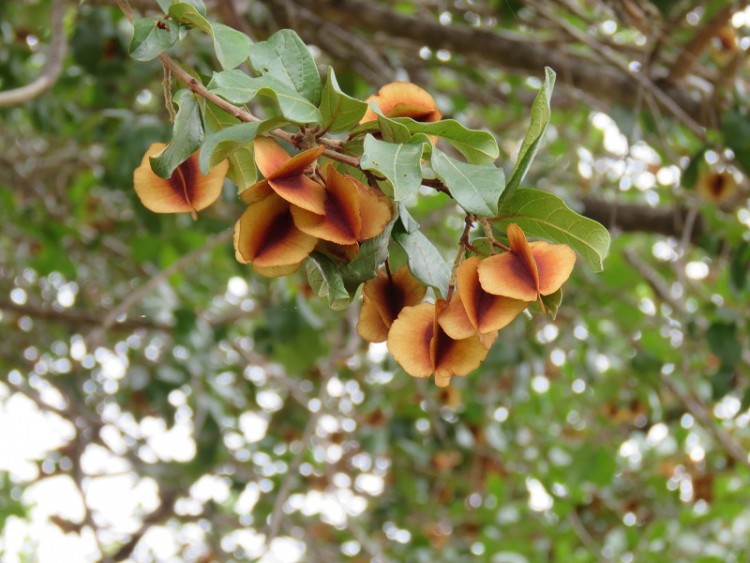 © Lisbeth
© Lisbeth
Kruger National Park
Description
Combretum apiculatum apiculatum deciduous, small to medium-sized tree. It is a single- or multi-stemmed, small tree 3-10 m high, with a short, often curved trunk, and a spreading, irregular canopy. The long, slender branches hang low down, giving the tree a willow-like appearance. It grows in higher rainfall regions. The bark on the main stem is grey to dark grey or brownish grey and smooth becoming scaly and rough with age.
The simple leaves have sharp, twisted tips, hence the specific epithet; they are shiny yellow-green in colour, alternate, opposite or in whorls of three at the nodes, with blades narrowly to broadly elliptic, oblong or broadly obovate. The base is roundish in outline. Young leaves are sticky.
Flowers occur in axils on new shoots, 3-4 on each shoot. Petals are yellow to creamy green and strongly scented. It flowers in spring and summer, from September to February. The fruit is four-winged, 20-30 x 15-25 mm, almost round to ovoid, with wings up to 7 mm wide, glutinous when young, yellowish-green, often tinged with red. It has a single seed in the centre. It fruits in late summer to autumn, from January to May. Fruits often stay on the tree until the next flowers appear in August.
Distribution
Red bushwillow is a widespread species in Africa, growing from KwaZulu-Natal and Mpumalanga and Limpopo (South Africa) to Botswana, Mozambique, Namibia, Zimbabwe and other parts of tropical Africa.
Habitat
occurs in various savanna regions, often at low altitudes and in rocky areas, on well-drained soil. It can grow on granitic and rhyolitic soils as well as in rocky places on basalt plains, especially in Mopane woodlands.
Links:
https://www.zimbabweflora.co.zw/species ... _id=141790
Order: Myrtales. Family: Combretaceae
Kruger National Park
Description
Combretum apiculatum apiculatum deciduous, small to medium-sized tree. It is a single- or multi-stemmed, small tree 3-10 m high, with a short, often curved trunk, and a spreading, irregular canopy. The long, slender branches hang low down, giving the tree a willow-like appearance. It grows in higher rainfall regions. The bark on the main stem is grey to dark grey or brownish grey and smooth becoming scaly and rough with age.
The simple leaves have sharp, twisted tips, hence the specific epithet; they are shiny yellow-green in colour, alternate, opposite or in whorls of three at the nodes, with blades narrowly to broadly elliptic, oblong or broadly obovate. The base is roundish in outline. Young leaves are sticky.
Flowers occur in axils on new shoots, 3-4 on each shoot. Petals are yellow to creamy green and strongly scented. It flowers in spring and summer, from September to February. The fruit is four-winged, 20-30 x 15-25 mm, almost round to ovoid, with wings up to 7 mm wide, glutinous when young, yellowish-green, often tinged with red. It has a single seed in the centre. It fruits in late summer to autumn, from January to May. Fruits often stay on the tree until the next flowers appear in August.
Distribution
Red bushwillow is a widespread species in Africa, growing from KwaZulu-Natal and Mpumalanga and Limpopo (South Africa) to Botswana, Mozambique, Namibia, Zimbabwe and other parts of tropical Africa.
Habitat
occurs in various savanna regions, often at low altitudes and in rocky areas, on well-drained soil. It can grow on granitic and rhyolitic soils as well as in rocky places on basalt plains, especially in Mopane woodlands.
Links:
https://www.zimbabweflora.co.zw/species ... _id=141790


